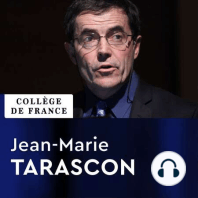Écoute de 60 min

Séminaire - Matthew Rosseinsky : Digital Routes to Inorganic Materials – A New Pathway for Ion Transport in Solids
Séminaire - Matthew Rosseinsky : Digital Routes to Inorganic Materials – A New Pathway for Ion Transport in Solids
évaluations:
Longueur:
43 minutes
Sortie:
4 mars 2024
Format:
Épisode de podcast
Description
Collège de FranceJean-Marie TarasconChimie du solide et de l'énergieAnnée 2023-2024Séminaire - Matthew Rosseinsky : Digital Routes to Inorganic Materials – A New Pathway for Ion Transport in SolidsMatthew Rosseinskyprofessor and head of the chemistry department, University of Liverpool, EnglandRésuméThe need for new materials to tackle societal challenges in energy and sustainability is widely acknowledged. As demands for performance increase while resource constraints narrow available options, the vastness of composition, structure and process parameter space make the apparently simple questions of where to look for and how to then find the materials we need a grand challenge to contemporary physical science. This talk will emphasise that discovery synthesis of new inorganic materials is at the extreme forefront of this endeavour.There has been a lot of excitement in the popular press and also in some scientific literature recently concerning the potential for artificial intelligence and robotics to transform the discovery of new materials. Given this, it is helpful to consider both useful definition of the word "new" and also how the claimed numbers of materials and the speeds with which they are accessed fit with the size of the space, and the differences in how composition can vary between solids and molecules.In this presentation, I will address the role of digital and robotic tools in discovery from the perspective of a researcher who targets the experimental realisation of new materials with structures that differ from those in the databases in a manner that has consequence for their functional performance.This will include the demonstration that it is now possible to guarantee to predict the crystal structure of a material based solely on its composition (Nature 619, 68, 2023), the role of machine learning from data in supporting decisions by experimental researchers (Nature Communications 12, 5561, 2021; J. Am. Chem. Soc. 144, 22178, 2022), and the acceleration of inorganic materials discovery with robots (Chemical Science 2024, DOI: 10.1039/D3SC05688K).The role of these digital tools in a modern integrated materials discovery workflow will be presented with an example of the discovery (i.e., the experimental realisation in the laboratory) of a quaternary inorganic solid that displays high lithium ion conductivity that arises from its new structure. This exemplifies the definition of scientifically useful novelty, as it leads to a different perspective on how lithium ions can attain high mobility in solids (accepted for publication, 2024). Such perspectives may prove generally helpful in the design of the fast ion transporting materials that we will need across future energy technologies.
Sortie:
4 mars 2024
Format:
Épisode de podcast
Titres dans cette série (57)
06 - Meilleurs matériaux pour l'énergie via la chimie du solide : synthèse et caractérisation de Chimie du solide et énergie - Jean-Marie Tarascon